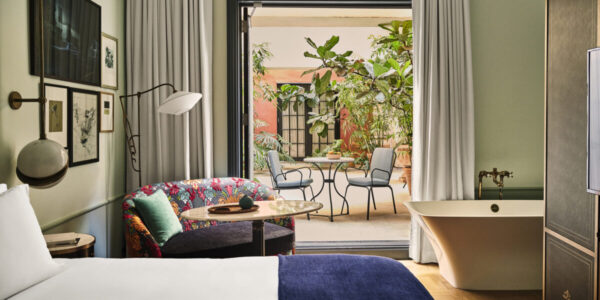
Raise a Ramada: Southwest romance
When Ann and Mike Liebert throw parties in their Tucson garden, guests are always slipping away to spend time in the ramada. The structure, with a beautiful nighttime view of downtown Tucson, feels like a retreat and draws guests like a magnet. “It’s irresistible,” says Ann.
This twiggy shelter – open on three sides to let the breezes blow through – was designed and built by Ed Kisto, a member of the Tohono O’odham, in the authentic Southwest style. Native Americans have been constructing similar sun shelters in the Sonoran desert for centuries using natural materials.
Ann always admired these traditional ramadas, but the idea of having one in her own garden occurred to her while she was working as a docent at the Arizona-Sonoran Desert Museum.
A fellow docent there, landscape architect Jeffrey Trent, told her about Ed Kisto and his artistry as a ramada builder, and he brought the two together. Though these structures were originally used to shelter workers from hot sun during harvest time, the Lieberts’ ramada is strictly for leisure – eating pomegranates with their grandchildren or relaxing after dinner.
Much as the Lieberts like using it, they also love just looking at it. “I ask you,” says Ann, “Could there be anything more Southwestern?”
DESIGN: Jeffrey Trent, Natural Order, Tucson (520/792-9274) and Ed Kisto.
HOW TO BUILD A RAMADA FOR YOURSELF
Choose materials to reflect your region. Though traditional ramadas were made with mesquite poles, ocotillo canes, and saguaro, these materials are not readily available in nurseries, and laws prevent harvesting from public land. Try eucalyptus, fir, or pine branches, or bamboo poles and palm fronds. Wood and stakes from a nursery or lumberyard would work. Build a more permanent structure with a solid or partially open roof; some modern versions even incorporate fireplaces, ceiling fans, and chaises.
Anchor the posts firmly. Kisto brushed the bottoms of the Lieberts’ ramada posts with motor oil to discourage termites, then buried them 18 inches, tamping the soil firmly around them. In windy areas, you might want to secure the posts in concrete. He used barbed wire to attach crossbeams to posts and bailing wire to lash ocotillo canes to the crossbeams.
Let the ramada’s style dictate the furnishings. In keeping with the simplicity of their ramada, the Lieberts use only a few pieces of informal furniture.
